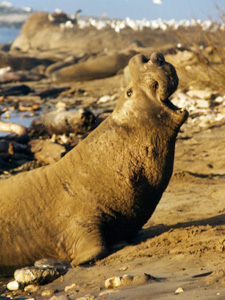
Northern Elephant Seals
Mirounga angustirostris
Mirounga fur is patchy and rough. You'd think this would protect them from hunters. Unfortunately, however, they have one trait in common with their distant cousins, the great whales. Oil-rich blubber. A large bull can yield 25 gallons of oil. Because of this, they were hunted ruthlessly throughout the 1800's and by the end the 19th century, they were believed to be extinct. Luckily, a small population, probably fewer than 100 seals, was found off the coast of Mexico and was protected by the Mexican government. The current population of approximately 160,000 seals is decended from those few animals.
That story alone would be enough for a good grin, but Miroungas are remarkable creatures in other ways as well. Although they breed, give birth, and moult on land, they spend months at a time at sea. Most of that time, they spend underwater. Their average dives last about half an hour, and they only linger on the surface for 3 to 5 minutes before they dive again. While they are underwater, their respiration slows and their heartbeat drops to 4 to 15 beats per minute. Their swimming is certainly imprssive, but the Mirounga trait that makes Grus REALLY grin is the males' challenge calls, which can be heard for miles. You can hear some of these in the Grooves section of the Garden.
Survival
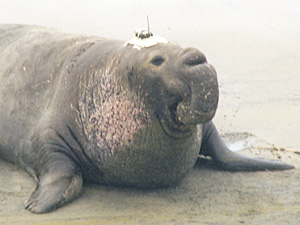
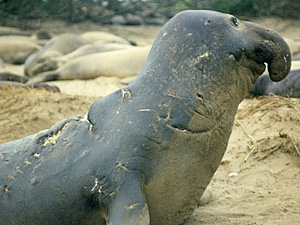
Primary Predators: Great White Sharks, Orcas, and historically Humans
The BAD NEWS: Their brush with extinction reduced Mirounga's genetic diversity. They are so genetically similar that researchers sometimes have difficulty using DNA tests to study paternity. This genetic homogeneity means they may be very vulnerable to disease, pollution and climate change.
Since elephant seals spend so many months at sea, they are difficult to study. While they are on land, researchers mark them for identification so they can observe their behavior. In order to better understand their diving behavior and trace their movements at sea, researchers equip a few seals with satellite transmitters. The bull on the right is sporting one. The researchers have learned some amazing things:
While at sea elephant seals dive 24 hours a day
Average dives: 1500 feet, 25 minutes
Deepest recorded dive: 5788 feet-over a mile!
Longest recorded dive: 119 minutes
Breeding Range: California and Mexico Coast
Feeding Range:
Males: Continental shelf as far north as Alaska
Females: Open waters west of breeding grounds
Time spent on land:
Breeding Season: December through March
Molting: 4-6 weeks in Spring or Summer
Typically return to birthplace to breed and molt
Each New Year Brings New Elephant Seals
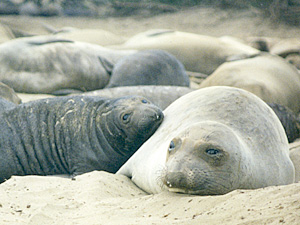
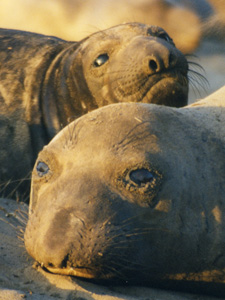
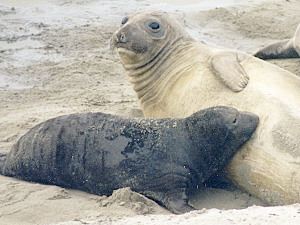
Pregnant females return to their breeding sites in Mexico and California from early December through early February and gather in groups called "harems." They don't eat anything when they're on land, so energy conservation is important. Although they give birth to their single pup within six days of their arrival, they nurse the pup for four weeks. During this period they lose over 1/3 of their body weight. Females and pups call back and forth in the first moments following birth so they can identify each other in the crowded harem. This imprinting is critical for the survival of the pups, since females do not have enough milk to support more than one pup. Until their pups are weaned, experienced females will defend them from other females and will drive other pups away.
Pup Vital Statistics:
Size at birth: 3-4 feet, 60-80 lbs.
Pups nurse for approximately 4 weeks
Size when weaned: 4-5 feet, 270-330 lbs.
Pups fast for approximately 10 weeks after weaning
At First Glance, Male Elephant Seals May LOOK Romantic...

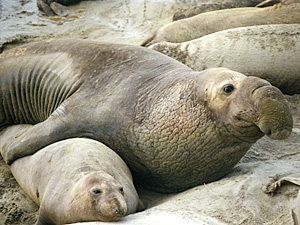
Male Elephant Seal Vital Statistics
Size: 11-15 feet, 3000 to 5000 lbs.
Prime breeding age: 9-12 years old
Fewer than 10% of males ever mate.
The large concentration of fertile females attracts the males. Elephant seals treat procreation very differently than the Grus family. They mate with as many females (and other things, including innanimate objects) as possible, even if the females are less than enthusiastic. Females have to get past aggessively amorous males to reach the safety of the harem, where they will give birth. The above pictures may make it look like they're cuddling, but...
If You Ask Her Though...
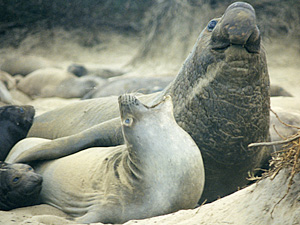
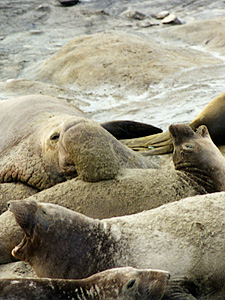

Elephant Seal Female Vital Statistics:
Size: 8-9 feet, 800-1500 lbs.
Gives birth to one pup per year
Average age of first pregnancy: 3-4 years
The females typically protest vociferously while mating, even with the alpha male. During the few days of nursing, female elephant seals become fertile. The dominant "alpha" bull attempts to keep the many subordinate bulls away from fertile females, but this takes a lot of energy and doesn't leave them much enthusiasm for romance!
Fights
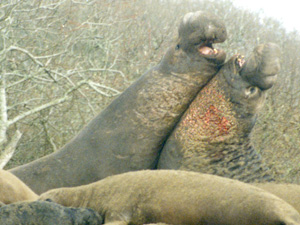
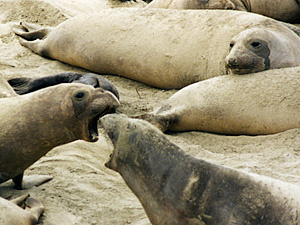
Naturally, whenever you get a bunch of solitary animals together, there's quite a bit of squabbling. The breeding season can be particularly hard on mature elephant seal bulls, who arrive at the rookeries in December and remain through the end of March. They fast for the entire time and lose more than 1/3 of their body weight, so energy conservation is extremely important. But the competition for the opportunity to mate is fierce. A few dominant males--called alpha bulls--do most of the mating, and fewer than 1/3 of the males present during the breeding season mate at all. Fights between bulls may be very intense and energy consuming, so, whenever possible, they assert their dominance in other ways.
Avoiding Fights
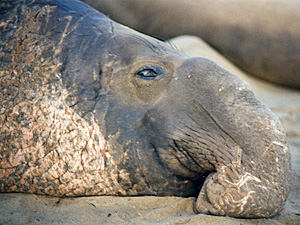

Frequently, an alpha bull can discourage a would be competitor by simply raising his head and staring. Typically, the intruder flees if he realizes the alpha is much stronger. Alpha bulls usually are much larger than their less successful counterparts. As they mature, bulls develop larger noses and extensive patches of scar tissue called "chest shields." These visual cues, combined with their size, help the older bulls intimidate and drive away less experienced competitors without actually fighting. The alpha bull on the right has a bigger nose and a bigger, brighter chest shield than the young bull on the left. The bull's challenge calls also may help them establish dominance. You can hear these calls in the Grooves section of the Garden.
Want to Learn More?